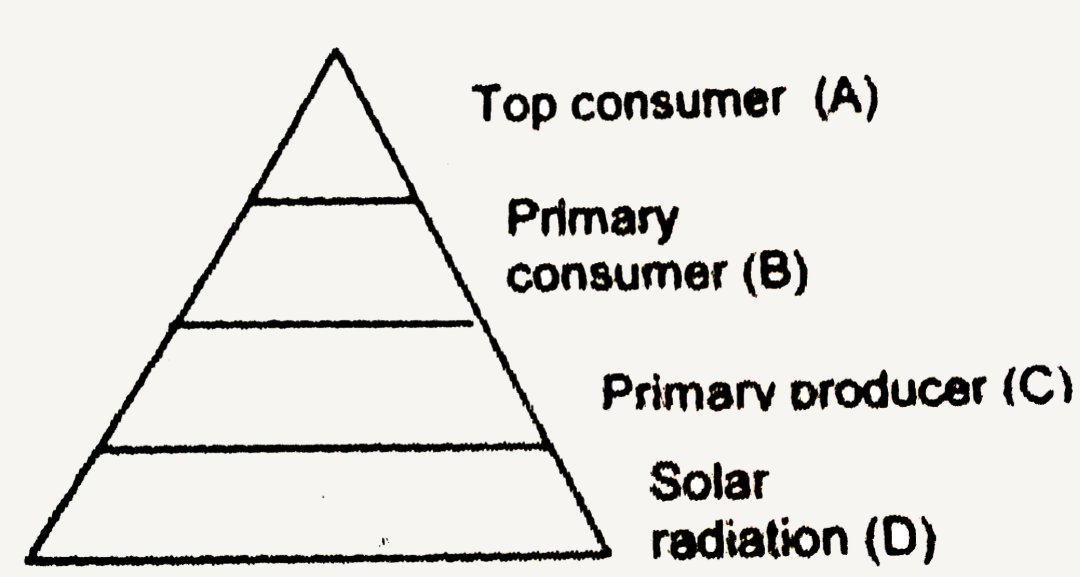
(A) 10kcal/m2/yr
(B) 100kcal/m2/yr
(C ) 1,000kcal/m2/yr
(D) 1,00,000kcal/m2/yr
In the above energy pyramid for an ecosystem, the rate of secondary production is Solution in Kannada
same
more
less
can not be ascertained from the data
The correct Answer is:A
Ecological efficiency is the percentage of energy converted into biomass by a higher trophic level over the energy of food resources available at the lower trophic level. In both cases mentioned in the question, it will be 1/10.
Topper's Solved these Questions
Similar Questions
[A] : Ecology is the study of interrelationship between living organisms and their non-living environment .
[R] : The biotic community and non-living environment of an area function together to form an ecosystem .
View SolutionState whether the following statement is true or false.
The natural ageing of a lake is called biomagnification.
View SolutionProductivity is the rate of production of biomass expressed in terms of
(i) (kcalm−3)yr−1
(ii) g−2yr−1
(iii) g−1yr−1 (iv) (kcalm−2)yr−1
View SolutionProductivity is the rate of production of biomass expressed in terms of:
i.(kcal m−3)yr−1ii.g−2yr−1iii.g−1yr−1iv.(kcal m−2)yr−1
View SolutionPrimary production is defined as the amount of biomass or organic matter produced per unit area over a time period by plants during photosynthesis . It is expressed in term of
(a) Weight (g−2) (b) Weight (g−2yr−1)
(c) Energy (kcal m−2) d. Energy (kcal m−2yr−1)
View SolutionProductivity is the rate of production of biomass expressed in terms of
(i) (kcalm−3)yr−1
(ii) g−2yr−1
(iii) g−1yr−1 (iv) (kcalm−2)yr−1
View SolutionProductivity is the rate of production of biomass expressed in terms of
i) (kcalm3)yr−1 ii) g−2yr−1
iii) g−1yr−1 iv) (kcal m−2)yr−1
View SolutionProductivity is the rate of production of biomass expressed in terms of
(i) (kcalm−3)yr−1
(ii) g−2yr−1
(iii) g−1yr−1 (iv) (kcalm−2)yr−1
View SolutionThe rate of production of biomass is called productivity. (i) (kcal m^(-3))yr^(-1) (ii) g^(-2) yr^(-1) (iii) g^(-1) yr^(-1) (iv) (kcal m^(-2) ) yr^(-1) Choose the correct answer
View SolutionProductivity is the rate of production of biomass expressed in terms of
(i) (kcalm−3)yr−1
(ii) g−2yr−1
(iii) g−1yr−1 (iv) (kcalm−2)yr−1
View SolutionProductivity is the rate of production of biomass expressed in terms of:
(i) (kcal m−3)yr−1
(ii) g−2yr−1
(iii) g−1yr−1
(iv) (kcal m−2)yr−1
View SolutionProductivity is the rate of production of biomass expressed in terms of:
(i) (kcalm−3)yr−1
(ii) g−2yr−1
(iii) g−1yr−1
(iv)(kcalm−2)yr−1
View Solution(A) 10 kcal//m^(2)//yr (B) 100 kcal//m^(2)//yr (C ) 1,000 kcal//m^(2)//yr (D) 1,00,000 kcal//m^(2)//yr In the above energy pyramid for an ecosystem, the rate of secondary production is
View SolutionProductivity is the rate of production of biomass expressed in terms of
(i) (kcalm−3)yr−1
(ii) g−2yr−1
(iii) g−1yr−1 (iv) (kcalm−2)yr−1
View Solution
(A) 10kcal/m2/yr
(B) 100kcal/m2/yr
(C ) 1,000kcal/m2/yr
(D) 1,00,000kcal/m2/yr
In the above energy pyramid for an ecosystem, the rate of secondary production is
View Solution(A) 10 kcal//m^(2)//yr (B) 100 kcal//m^(2)//yr (C ) 1,000 kcal//m^(2)//yr (D) 1,00,000 kcal//m^(2)//yr In the above energy pyramid for an ecosystem, the rate of secondary production is
View Solution
